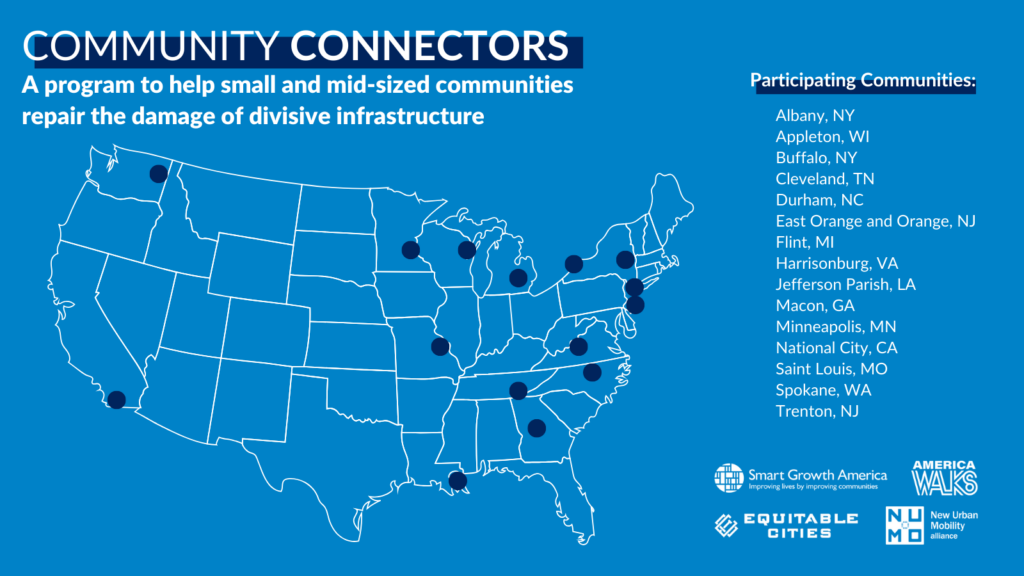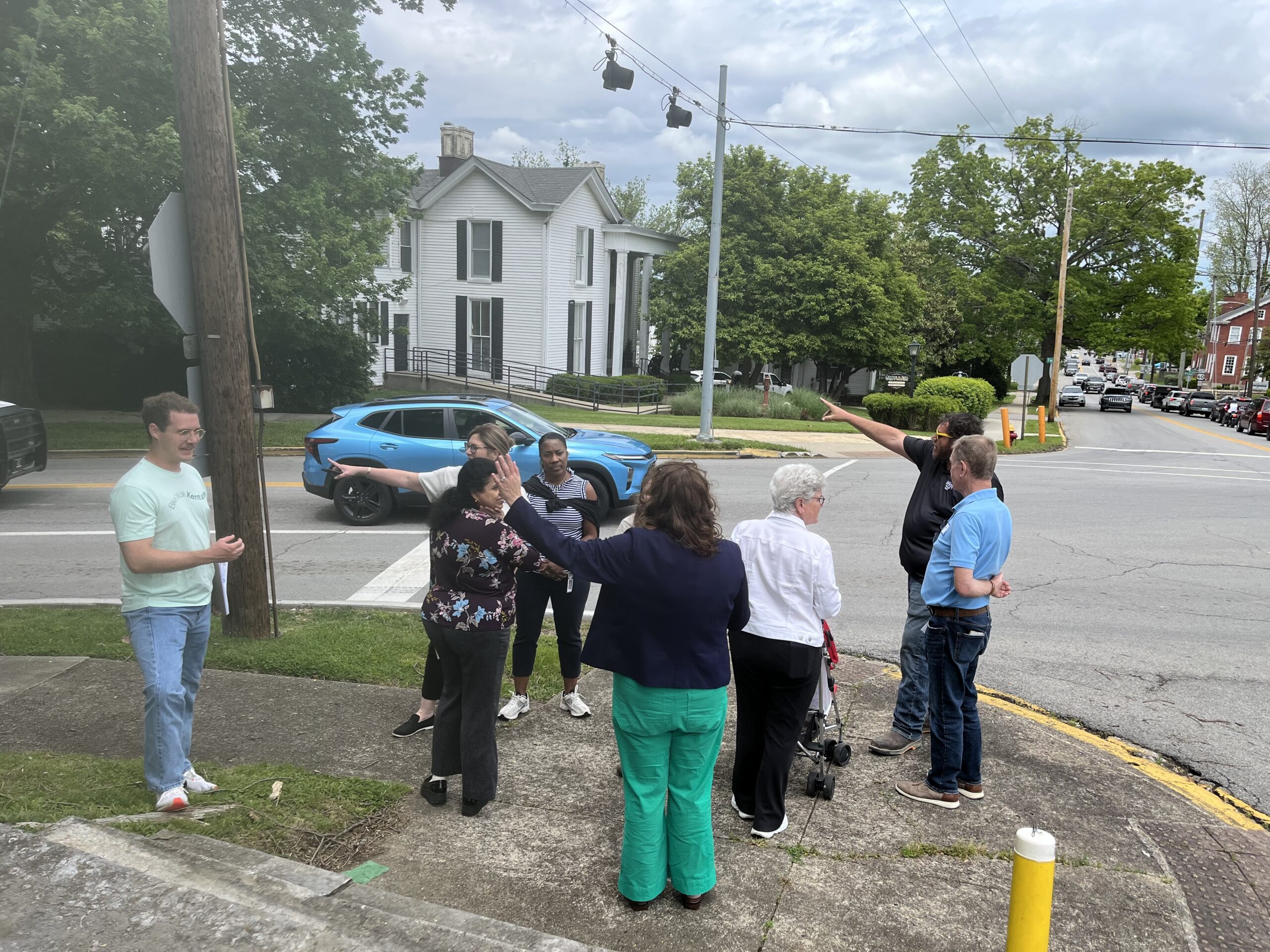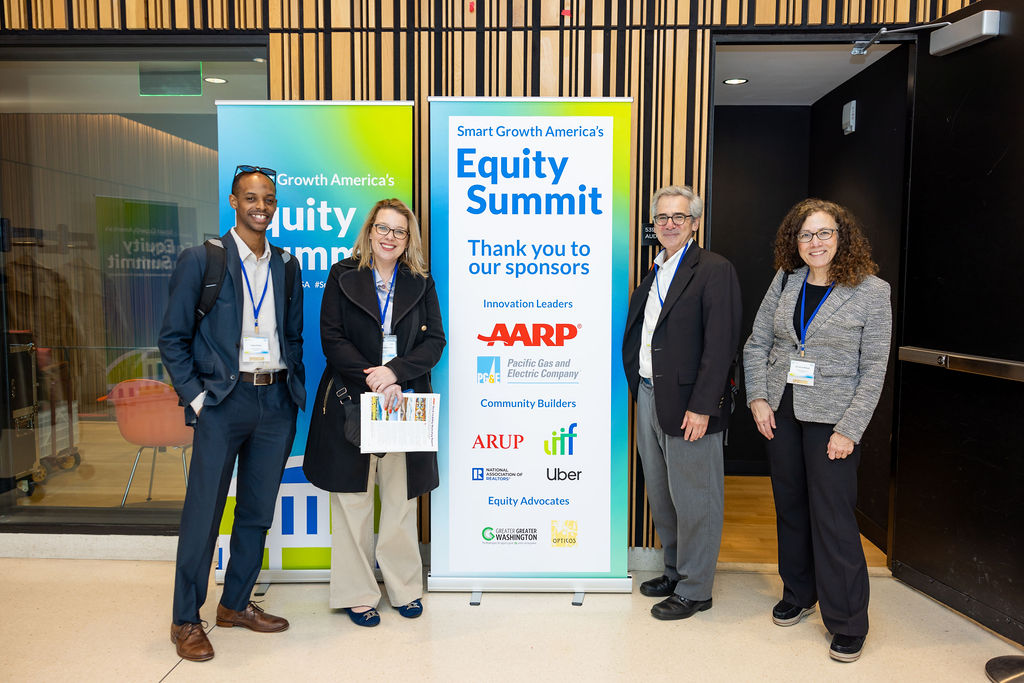Community Connectors Program
Supporting leaders in small and mid-sized communities—in and out of government—to repair the damage of divisive infrastructure.
With support from the Robert Wood Johnson Foundation, Smart Growth America in collaboration with Equitable Cities, the New Urban Mobility Alliance, and America Walks have created the Community Connectors program to help advance locally driven projects that will reconnect communities separated or harmed by transportation infrastructure and tap available federal and state funds to support them. 15 teams from small to mid-sized cities have been selected to receive a capacity-building grant to advance these projects.
These projects will receive grants of up to $130,000 to build local capacity to co-design projects alongside impacted communities to advance new transportation infrastructure projects that repair damage from divisive infrastructure. The Community Connectors program will take place over the next two years and features a learning exchange this November in Atlanta, GA and links local leaders to experts and other cities attempting to accomplish similar objectives in reconnecting communities.
The 2023 Community Connectors Cohort
[Click to expand for project details]
Albany Riverfront Collaborative
The Albany Riverfront Collaborative has marshaled broad support for reimaging Interstate 787, which isolates neighborhoods from downtown and the Hudson River. The process is already underway and the Albany Riverfront Collaborative wants to make sure the outcome provides direct health, safety, and economic benefits to the communities harmed by I-787.
City of Appleton
The 2.5-mile College Avenue Corridor runs adjacent to a number of Appleton communities, including three out of Outagamie County’s five disadvantaged Justice40 communities. Led by the county and in partnership with local organizations, this effort aims to transform the corridor’s existing car-centric infrastructure to better use space; improve access to commercial and employment hubs, community anchors, and residences; and prioritize equitable access and safety by building sidewalks, bike paths, and other missing infrastructure.
Niagara Frontier Transportation Authority
Buffalo’s Bailey Avenue corridor is one of the most densely populated, low-income, zero-or-one-car household areas in western New York. The Niagara Frontier Transportation Authority has plans to implement a Battery Electric Bus Rapid Transit system along the corridor, to better serve the transportation needs of Bailey Avenue residents.
City Fields
Cleveland is making investments to put the neighborhoods along East Inman Street back together. Long divided by a rail line and an arterial road, the City now has funding to reconnect the College Hill and Blythe Oldfield neighborhoods. The City Fields Community Development Corporation is convening and working with residents to empower them during this major infrastructure project.
Merrick-Moore Community Development Corporation
The Merrick-Moore Community Development Corporation has identified a problem in Durham: missing and limited public transit exacerbates challenges experienced in the Black communities of Bragtown and Merrick-Moore. The Merrick-More CDC works with Durham Public Schools and the Durham City/County Planning Department to overcome mobility barriers limiting opportunity.
The City of East Orange and the City of Orange Township
The construction of I-280 and Freeway Drive through East Orange and Orange in the 1960s continues to have significant quality-of-life impacts on residents more than 60 years later. The City of East Orange and the City of Orange Township are taking a comprehensive look at remedying the economic, environmental, and connectivity problems these roads cause and are developing a project scope to gain state buy-in.
Crim Fitness Foundation
Interstate 475 bisected Flint’s South Saginaw and East Side neighborhoods in 1973, a decision that prioritized the movement of cars and freight over community connections. As the Michigan Department of Transportation looks to reduce the highway’s footprint, the Crim Fitness Foundation and its community partners have teamed up with the City of Flint to build a broad community vision for improved connectivity, equitable reinvestment, and the reintroduction of public spaces on land reclaimed from the highway.
City of Harrisonburg
The construction of North Mason Street and additional “urban renewal” activities resulted in displacement and the loss of many Black-owned homes and businesses in the Northeast Neighborhood of Harrisonburg, Virginia. The city will work with the Northeast Neighborhood Association, Harrisonburg Downtown Renaissance, the Shenandoah Valley Black Heritage Project, and the broader community to develop a plan to reestablish a safe, vibrant corridor to reconnect the neighborhood to the historic fabric of downtown Harrisonburg.
Jefferson Parish
Two major railroad lines pass directly through the streets of densely populated communities in Jefferson Parish, hindering their economic vitality and creating ongoing safety, air pollution, and congestion challenges. A coalition of stakeholders led by Jefferson Parish, the Plaquemines Port Harbor and Terminal District, and the city of Gretna will work with the community to realign two segments of the railroad to incorporate new uses like greenway and transit connections.
Macon Bibb County Community Enhancement Authority
The historic neighborhood of Pleasant Hill in Macon experienced disinvestment and displacement after the construction of Interstate 75, which split the neighborhood in half. As Pleasant Hill undergoes a $10-million mitigation plan that will widen the I-75/I-16 interchange, the Macon Bibb County Community Enhancement Authority, county, and neighborhood and development organizations are eager to improve infrastructure and pedestrian safety, provide commercial opportunity, improve health outcomes, and increase home values along a key downtown street.
Our Streets Minneapolis
Sixth Avenue North was once a vibrant, predominantly Black business corridor before the street was expanded to become Olson Memorial Highway. Our Streets Minneapolis, in partnership with local residents and businesses, seeks to restore Sixth Avenue as the backbone of a walkable, locally-owned commercial district.
Mundo Gardens
The National City Southeast Greenspace Corridor Project unifies National City and Southeast San Diego through reforestation, cultural art, and community. By creating green space and safe pathways across the 805 Freeway corridor, residents can enjoy a dignified experience in their community.
Read this blog post about the National City team’s ongoing work
St. Louis Arts Chamber of Commerce
Jim Crow laws, redlining, traffic-flow projects, and development patterns have resulted in the displacement of residents, particularly Black residents, from the neighborhoods north of Delmar in Saint Louis, and the subsequent destruction of shared experiences and culture. A non-profit community organization is working with the city to reconnect historically underserved neighborhoods to three adjoining arts and business districts, and to develop a cohesive plan to bring in additional partners, secure more funding, conduct meaningful community engagement, and incorporate transit and multimodal elements.
East Central is one of the most diverse communities in Spokane and developed as a strong community of working-class and immigrant families in the early 1900s. Interstate 90 split the neighborhood in 1961, destroying parks, businesses, and homes. The City of Spokane seeks solutions to remedy these harms and build trust and new relationships with East Central residents.
New Jersey Future
Route 29 separates Trenton from the Delaware River, cutting residents off from a unique natural resource. New Jersey Future is working with community partners and the City of Trenton to channel widespread enthusiasm for redesigning Route 29 as a waterfront boulevard into concrete action.
Learn about the damage done by divisive infrastructure
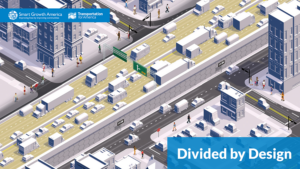 Beginning in the 1950s, highways devastated communities of color and changed our cities forever. But the consequences continue, even as we begin to acknowledge our past mistakes. Why?
Beginning in the 1950s, highways devastated communities of color and changed our cities forever. But the consequences continue, even as we begin to acknowledge our past mistakes. Why?
Our report, Divided by Design, examines the racist roots of our current transportation system, revealing that flawed thinking continues to haunt our policies and practices. Without a fundamental change to the overall approach to transportation, today’s leaders and transportation professionals, no matter their intent, will perpetuate and exacerbate the damage.
To create a better system, we can’t settle for small changes. We need a total shift in approach.
While only 15 teams/cities will be selected for this program, anyone advancing similar projects can tap Transportation for America’s Community Connectors portal of resources. (Transportation for America is a program of Smart Growth America.) Whether trying to stop a divisive, destructive, and unaffordable freeway expansion, steer more resources to transit, or advance a Reconnecting Communities project to remove an old highway or make wide, dangerous arterial roads a little safer for people to cross, the Community Connectors portal decodes the processes, explains common terms, clarifies the important actors, and inspires with helpful real-world stories. Dig in at t4america.org/community-connectors 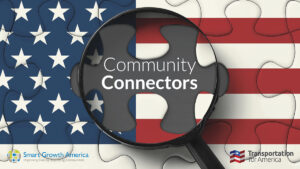 Community Connectors: Free tools for advocates
Community Connectors: Free tools for advocates
Community Connectors program partners
Roadblocks to safety: How state preemption puts pedestrians at risk
Pedestrian fatalities have seen a 75 percent spike since 2010. Communities need to take urgent action to slow cars, improve crossings, and create streets that prioritize safety over speed. Unfortunately, more and more are facing unnecessary barriers from state governments as they put questionable limits on the types of funding, street design changes, and other … Continued
Building forward: Three takeaways from the 2025 Equity Summit
Earlier this spring, our 2025 Equity Summit brought smart growth leaders, advocates, and practitioners together to explore how communities can work together to address their most pressing priorities for the built environment. From moving beyond housing scarcity to focusing on outcomes over process, the conversations we had over our two days together helped us gain … Continued
